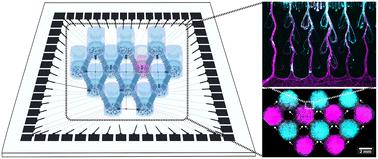Our official English website, www.x-mol.net, welcomes your
feedback! (Note: you will need to create a separate account there.)
Engineered cortical microcircuits for investigations of neuroplasticity
Lab on a Chip ( IF 6.1 ) Pub Date : 2024-09-03 , DOI: 10.1039/d4lc00546e Nicolai Winter-Hjelm 1 , Pawel Sikorski 2 , Axel Sandvig 1, 3 , Ioanna Sandvig 1
Lab on a Chip ( IF 6.1 ) Pub Date : 2024-09-03 , DOI: 10.1039/d4lc00546e Nicolai Winter-Hjelm 1 , Pawel Sikorski 2 , Axel Sandvig 1, 3 , Ioanna Sandvig 1
Affiliation

|
Recent advances in neural engineering have opened new ways to investigate the impact of topology on neural network function. Leveraging microfluidic technologies, it is possible to establish modular circuit motifs that promote both segregation and integration of information processing in the engineered neural networks, similar to those observed in vivo. However, the impact of the underlying topologies on network dynamics and response to pathological perturbation remains largely unresolved. In this work, we demonstrate the utilization of microfluidic platforms with 12 interconnected nodes to structure modular, cortical engineered neural networks. By implementing geometrical constraints inspired by a Tesla valve within the connecting microtunnels, we additionally exert control over the direction of axonal outgrowth between the nodes. Interfacing these platforms with nanoporous microelectrode arrays reveals that the resulting laminar cortical networks exhibit pronounced segregated and integrated functional dynamics across layers, mirroring key elements of the feedforward, hierarchical information processing observed in the neocortex. The multi-nodal configuration also facilitates selective perturbation of individual nodes within the networks. To illustrate this, we induced hypoxia, a key factor in the pathogenesis of various neurological disorders, in well-connected nodes within the networks. Our findings demonstrate that such perturbations induce ablation of information flow across the hypoxic node, while enabling the study of plasticity and information processing adaptations in neighboring nodes and neural communication pathways. In summary, our presented model system recapitulates fundamental attributes of the microcircuit organization of neocortical neural networks, rendering it highly pertinent for preclinical neuroscience research. This model system holds promise for yielding new insights into the development, topological organization, and neuroplasticity mechanisms of the neocortex across the micro- and mesoscale level, in both healthy and pathological conditions.
中文翻译:

用于研究神经可塑性的工程皮质微电路
神经工程的最新进展为研究拓扑对神经网络功能的影响开辟了新的方法。利用微流体技术,可以建立模块化电路基序,促进工程神经网络中信息处理的分离和集成,类似于在体内观察到的那些。然而,底层拓扑对网络动力学和对病态扰动的响应的影响在很大程度上仍未解决。在这项工作中,我们展示了利用具有 12 个互连节点的微流体平台来构建模块化的皮层工程神经网络。通过在连接的微隧道中实施受特斯拉阀启发的几何约束,我们还控制了节点之间轴突生长的方向。将这些平台与纳米多孔微电极阵列连接表明,所得的层状皮层网络在各层之间表现出明显的分离和集成功能动力学,反映了在新皮层中观察到的前馈、分层信息处理的关键元素。多节点配置还有助于对网络内的各个节点进行选择性扰动。为了说明这一点,我们在网络内连接良好的节点中诱导了缺氧,这是各种神经系统疾病发病机制的关键因素。我们的研究结果表明,这种扰动诱导了通过缺氧节点的信息流消融,同时能够研究相邻节点和神经通信通路中的可塑性和信息处理适应。 总之,我们提出的模型系统概括了新皮层神经网络微电路组织的基本属性,使其与临床前神经科学研究高度相关。该模型系统有望在健康和病理条件下,在微尺度和中尺度水平上对新皮层的发育、拓扑组织和神经可塑性机制产生新的见解。
更新日期:2024-09-03
中文翻译:

用于研究神经可塑性的工程皮质微电路
神经工程的最新进展为研究拓扑对神经网络功能的影响开辟了新的方法。利用微流体技术,可以建立模块化电路基序,促进工程神经网络中信息处理的分离和集成,类似于在体内观察到的那些。然而,底层拓扑对网络动力学和对病态扰动的响应的影响在很大程度上仍未解决。在这项工作中,我们展示了利用具有 12 个互连节点的微流体平台来构建模块化的皮层工程神经网络。通过在连接的微隧道中实施受特斯拉阀启发的几何约束,我们还控制了节点之间轴突生长的方向。将这些平台与纳米多孔微电极阵列连接表明,所得的层状皮层网络在各层之间表现出明显的分离和集成功能动力学,反映了在新皮层中观察到的前馈、分层信息处理的关键元素。多节点配置还有助于对网络内的各个节点进行选择性扰动。为了说明这一点,我们在网络内连接良好的节点中诱导了缺氧,这是各种神经系统疾病发病机制的关键因素。我们的研究结果表明,这种扰动诱导了通过缺氧节点的信息流消融,同时能够研究相邻节点和神经通信通路中的可塑性和信息处理适应。 总之,我们提出的模型系统概括了新皮层神经网络微电路组织的基本属性,使其与临床前神经科学研究高度相关。该模型系统有望在健康和病理条件下,在微尺度和中尺度水平上对新皮层的发育、拓扑组织和神经可塑性机制产生新的见解。


















































 京公网安备 11010802027423号
京公网安备 11010802027423号